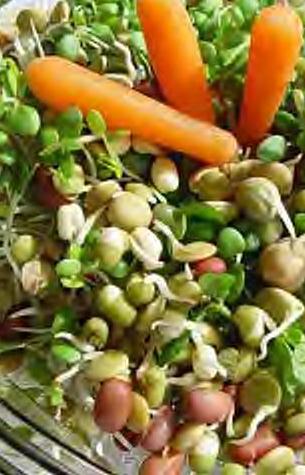|
|
Nutrition, nourishment, or aliment, is the supply
of materials - food - required by organisms and cells to stay
alive. In science and human medicine, nutrition is the science or
practice of consuming and utilizing foods. In hospitals, nutrition
may refer to the food requirements of patients, including
nutritional solutions delivered via an IV (intravenous) or IG (intragastric)
tube.
Nutritional science studies how the body breaks food down
(catabolism) and repairs and creates cells and tissue (anabolism)
- catabolism and anabolism = metabolism. Nutritional science also
examines how the body responds to food. In other words,
"nutritional science investigates the metabolic and physiological
responses of the body to diet".
As molecular biology, biochemistry and genetics advance, nutrition
has become more focused on the steps of biochemical sequences
through which substances inside us and other living organisms are
transformed from one form to another - metabolism and metabolic
pathways.
Nutrition also focuses on how diseases, conditions and problems
can be prevented or lessened with a healthy diet.
Nutrition also involves identifying how certain diseases,
conditions or problems may be caused by dietary factors, such as
poor diet (malnutrition), food allergies, metabolic diseases, etc.
What is the difference between a dietician and a nutritionist?
A dietician studied dietetics, while a nutritionist studied
nutrition. The two terms are often interchangeable, however they
are not 100% identical.
• Dietetics: the interpretation and communication of the science
of nutrition so that people can make informed and practical
choices about food and lifestyle, in both health and disease. Part
of a dietician's course includes both hospital and community
settings. The majority of dieticians work in health care,
education and research, while a much smaller proportion also work
in the food industry. A dietician must have a recognized degree
(B.Sc. or M.Sc), or postgraduate degree in nutrition and dietetics
to work as a dietician.
• Nutrition: the study of nutrients in food, how the body uses
nutrients, and the relationship between diet, health and disease.
Major food manufacturers employ nutritionists and food scientists.
Nutritionists may also work in journalism, education and research.
Many nutritionists work in the field of food science and
technology.
There is a lot of overlap between what nutritionists and
dieticians do and studied. Some nutritionists work in health care,
some dieticians work in the food industry, but a higher percentage
of nutritionists work in the food industry and food science and
technology, and a higher percentage of dieticians work in health
care.
One could very loosely generalize and say that a nutritionist
focuses firstly on a food, and then looks at its effects on
people, while a dietician looks at the human, and then how that
human's health is influenced by food.
If I discovered a new fruit and wanted to find out what it
consisted of I would go to a nutritionist. If I found out I had a
long-term disease and wanted to know whether I needed to adjust my
food intake because of the disease, I would go to a dietician.
Please bear in mind that this very loose comparison is both
subjective and possibly too geographically bound on my part
(British, National Health Service), and is simply aimed at
exaggerating the differences so that lay people may see some gap
between the two - differences and disagreements in my
interpretation will exist in different countries, within regions
of a countries, and also from college to college - and many in
those areas will disagree with each other.
From what I can glean from hundreds of studies and texts that I
read as an editor of a medical journal, in the USA, Australia, and
to a lesser extent in the UK and the Republic of Ireland, people
who call themselves dieticians are more likely to have full
university bachelor's or postgraduate qualifications, while
nutritionists mostly do as well, but a higher proportion may not.
In the US, dietitians are registered or licensed with the
Commission for Dietetic Registration and the American Dietetic
Association, and are only able to use the title dietitian as
described by the business and professions codes of each respective
state, when they have met specific educational and work experience
requirements and passed a national registration or licensure
examination, respectively.
Everyone in medicine is involved in nutrition
If you ask any health care professional, be it a doctor, nurse,
psychologist, or dentist to identify a part of medicine that is
not at all related to nutrition, there will be a long silence as
they scratch their heads.
Nutrition is present in all processes of life. Right from the very
moment the sperm fertilizes an egg, through fetal development in
the uterus, to the birth, human growth, maturity, old age, and
eventual death. Even after death the human body serves as
nutrition for other organisms. Anything that involves life and
chemical or biochemical movement has nutrition at its core.
Anything that lives is dependent on energy, which results from the
combustion of food.
The human body requires seven major types of nutrients
A nutrient is a source of nourishment, an ingredient in a food,
e.g. protein, carbohydrate, fat, vitamin, mineral, fiber and
water. Macronutrients are nutrients we need in relatively large
quantities. Micronutrients are nutrients we need in relatively
small quantities.
Energy macronutrients - these provide energy, which is measured
either in kilocalories (kcal) or Joules. 1 kcal = 4185.8 joules.
• Carbohydrates - 4 kcal per gram
Molecules consist of carbon, hydrogen and oxygen atoms.
Carbohydrates include monosaccharide (glucose, fructose, glactose),
sisaccharides, and polysaccharides (starch).
Nutritionally, polysaccharides are more favored for humans because
they are more complex molecular sugar chains and take longer to
break down - the more complex a sugar molecule is the longer it
takes to break down and absorb into the bloodstream, and the less
it spikes blood sugar levels. Spikes in blood sugar levels are
linked to heart and vascular diseases.
• Proteins - 4 kcal per gram
Molecules contain nitrogen, carbon, hydrogen and oxygen. Simple
proteins, called monomers, are used to create complicated
proteins, called polymers, which build and repair tissue. When
used as a fuel the protein needs to break down, as it breaks down
it gets rid of nitrogen, which has to be eliminated by the
kidneys.
• Fats - 9 kcal per gram
Molecules consist of carbon, hydrogen, and oxygen atoms. Fats are
triglycerides - three molecules of fatty acid combined with a
molecule of the alcohol glycerol. Fatty acids are simple compounds
(monomers) while triglycerides are complex molecules (polymers).
For more details on dietary fat, go to What is fat? How much fat
should I eat?
Other macronutrients. These do not provide energy
• Fiber
Fiber consists mostly of carbohydrates. However because of its
limited absorption by the body, not much of the sugars and
starches get into the blood stream. Fiber is a crucial part of
essential human nutrition. For more details go to What is fiber?
What is dietary fiber?
• Water
About 70% of the non-fat mass of the human body is water. Nobody
is completely sure how much water the human body needs - claims
vary from between one to seven liters per day to avoid
dehydration. We do know that water requirements are very closely
linked to body size, age, environmental temperatures, physical
activity, different states of health, and dietary habits. Somebody
who consumes a lot of salt will require more water than another
person of the same height, age and weight, exposed to the same
levels of outside temperatures, and similar levels of physical
exertion who consumes less salt. Most blanket claims that 'the
more water you drink the healthier your are' are not backed with
scientific evidence. The variables that influence water
requirements are so vast that accurate advice on water intake
would only be valid after evaluating each person individually.
Micronutrients
• Minerals
Dietary minerals are the other chemical elements our bodies need,
apart from carbon, hydrogen, oxygen and nitrogen. The term
"minerals" is misleading, and would be more relevant if called
"ions" or "dietary ions" (it is a pity they are not called so).
People whose intake of foods is varied and well thought out -
those with a well balanced diet - will in most cases obtain all
their minerals from what they eat. Minerals are often artificially
added to some foods to make up for potential dietary shortages and
subsequent health problems. The best example of this is iodized
salt - iodine is added to prevent iodine deficiency, which even
today affects about two billion people and causes mental
retardation and thyroid gland problems. Iodine deficiency remains
a serious public health problem in over half the planet.
• Vitamins
These are organic compounds we require in tiny amounts. An organic
compound is any molecule that contains carbon. It is called a
vitamin when our bodies cannot synthesize (produce) enough or any
of it. So we have to obtain it from our food. Vitamins are
classified by what they do biologically - their biological and
chemical activity - and not their structure.
Vitamins are classified as water soluble (they can dissolve in
water) or fat soluble (they can dissolve in fat). For humans there
are 4 fat-soluble (A, D, E, and K) and 9 water-soluble (8 B
vitamins and vitamin C) vitamins - a total of 13.
Water soluble vitamins need to be consumed more regularly because
they are eliminated faster and are not readily stored. Urinary
output is a good predictor of water soluble vitamin consumption.
Several water-soluble vitamins are manufactured by bacteria.
Fat soluble vitamins are absorbed through the intestines with the
help of fats (lipids). They are more likely to accumulate in the
body because they are harder to eliminate quickly. Excess levels
of fat soluble vitamins are more likely than with water-soluble
vitamins - this condition is called hypervitaminosis. Patients
with cystic fibrosis need to have their levels of fat-soluble
vitamins closely monitored.
Deficiency disease - greater tendency to bleed.
Overdose disease - may undermine effects of warfarin.
Most foods contain a combination of some, or all of the seven
nutrient classes. We require some nutrients regularly, and others
less frequently. Poor health may be the result of either not
enough or too much of a nutrient, or some nutrients - an
imbalance.
Nutrition in medical education
Historically, experts in medical education - people who decide
what medical students should learn - have all agreed that some
aspects of nutrition should be included in courses. However, the
greatest obstacle for a very long time was agreeing about what to
teach. In 1989 the American Society for Clinical Nutrition
Committee on Medical/Dental School and Residency Nutrition
Education published a list of 26 high-priority topics that should
form part of the medical curriculum. Those given the highest
priority were:
• Obesity
• Diet
• Hypelipidemias and atherosclerosis
• Diet and diabetes
• Pregnancy and lactation
|
|






